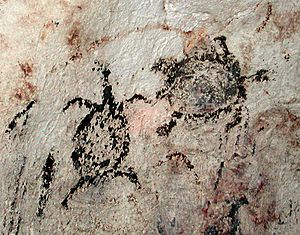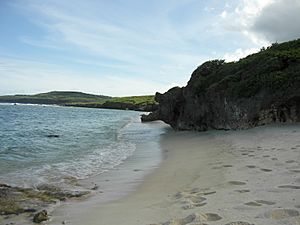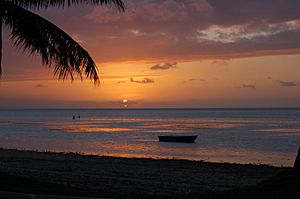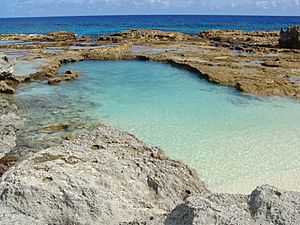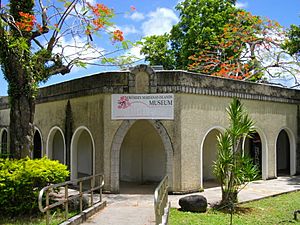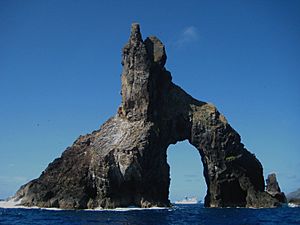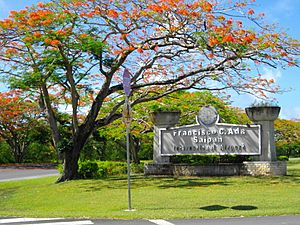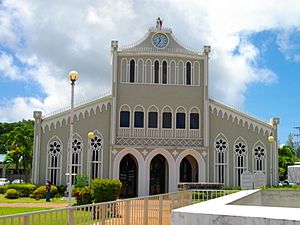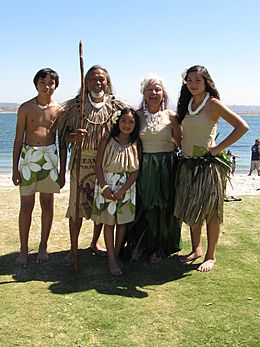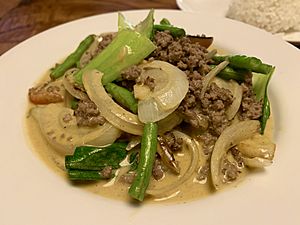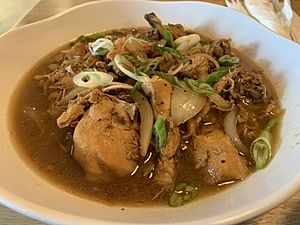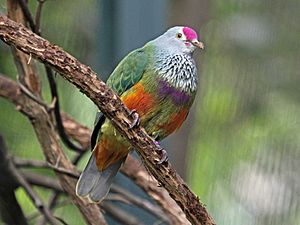Northern Mariana Islands facts for kids
Quick facts for kids
Northern Mariana Islands
|
|||
|---|---|---|---|
| Commonwealth of the Northern Mariana Islands Sankattan Siha Na Islas Mariånas (Chamorro) Commonwealth Téél Falúw kka Efáng llól Marianas (Carolinian) |
|||
|
|||
| Anthem: "Gi Talo Gi Halom Tasi" (Chamorro) "Satil Matawal Pacifiko" (Carolinian) ("In the Middle of the Sea") |
|||
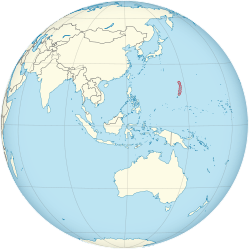
Location of the Northern Mariana Islands
(circled in red) |
|||
| Sovereign state | |||
| Before association with the United States | Trust Territory of the Pacific Islands | ||
| Commonwealth status | January 9, 1978 | ||
| End of U.N. Trusteeship | November 4, 1986 | ||
| Capital
and largest city
|
Saipan 15°11′N 145°44′E / 15.19°N 145.74°E |
||
| Official languages | |||
| Ethnic groups
(2023)
|
|
||
| Religion
(2010)
|
|
||
| Demonym(s) | Northern Mariana Islander (formal) Northern Marianan (other) Marianan (diminutive form) Chamorro (colloquial) |
||
| Government | Devolved presidential constitutional dependency | ||
| Joe Biden (D) | |||
|
• Governor
|
Arnold Palacios (I) | ||
|
• Lieutenant Governor
|
David M. Apatang (I) | ||
| Legislature | Commonwealth Legislature | ||
| Senate | |||
| House of Representatives | |||
| United States Congress | |||
|
• House delegate
|
Gregorio Sablan (D) | ||
| Area | |||
|
• Total
|
464 km2 (179 sq mi) | ||
|
• Water (%)
|
negligible | ||
| Highest elevation | 965 m (3,166 ft) | ||
| Population | |||
|
• 2022 estimate
|
55,650 (209th) | ||
|
• 2020 census
|
47,329 | ||
|
• Density
|
113/km2 (292.7/sq mi) (97th) | ||
| GDP (PPP) | 2016 estimate | ||
|
• Total
|
$1.24 billion | ||
|
• Per capita
|
$25,516 | ||
| GDP (nominal) | 2019 estimate | ||
|
• Total
|
$1.18 billion | ||
|
• Per capita
|
$21,239 | ||
| Currency | United States dollar (US$) (USD) | ||
| Time zone | UTC+10:00 (ChST) | ||
| Date format | mm/dd/yyyy | ||
| Driving side | right | ||
| Calling code | +1-670 | ||
| USPS abbreviation |
MP
|
||
| Trad. abbreviation |
CNMI
|
||
| ISO 3166 code |
|
||
| Internet TLD | .mp | ||
The Northern Mariana Islands, officially called the Commonwealth of the Northern Mariana Islands, is a special territory of the United States. It is made up of 14 islands in the northwestern Pacific Ocean. These islands are the northern part of the Mariana Islands chain. The southernmost island, Guam, is a separate U.S. territory. The Northern Mariana Islands were managed by the United Nations until 1990.
For a long time, the Northern Marianas were controlled by different countries. First, they were part of the Spanish Empire. Then, they were taken over by the German colonial empire, and later by the Empire of Japan. After World War II, the islands were looked after by the United States as part of a UN trust territory. In 1986, they officially joined the United States as a territory, and the people living there became U.S. citizens.
The islands cover about 183.5 square miles (475 square kilometers) of land. In 2020, about 47,329 people lived in the Northern Mariana Islands. Most of these people live on the islands of Saipan, Tinian, and Rota. The other islands are mostly empty. For example, Pagan has been mostly uninhabited since a volcano erupted there in 1981.
The main administrative center is Capitol Hill, a small village on Saipan. The current governor is Arnold Palacios, who started his job in January 2023. The government has two parts that make laws: a Senate with 9 members and a House of Representatives with 14 members.
Contents
History of the Islands
The islands were first settled around 1500 BC by people who traveled across the ocean. Over time, different countries claimed the islands.
Early Settlers and Ancient Life
The Mariana Islands were the first islands in Remote Oceania to be settled by humans. These early travelers came from the Philippines around 1500 to 1400 BC. Later, more people arrived from the Caroline Islands and Island Southeast Asia.
The islanders eventually became known as the Chamorros. This name came from a Spanish word similar to Chamori, which was the name for the higher class in their old caste system.
The ancient people of the Marianas built large stone pillars called latte stones. They built their homes on top of these pillars. When the Spanish arrived, some of the largest latte stones were already in ruins. The Chamorros believed that their ancestors who built these stones had special, supernatural powers.
In 2013, archaeologists suggested that the first people to settle in the Marianas might have made the longest ocean journey without stopping in human history at that time. Evidence from archaeology also suggests that Tinian might have been the very first Pacific island to be settled.
Spanish Rule and Changes
The first Europeans to arrive in the Mariana Islands were Ferdinand Magellan and his crew in 1521. Magellan was a Portuguese explorer sailing for Spain. He landed on Guam, the southernmost island, and claimed all the islands for Spain.
When Magellan's ships arrived, the native Chamorros came out to meet them. They offered food and drinks. However, they also took a small boat from Magellan's fleet. In Chamorro culture, sharing was common, and taking something needed, like a boat for fishing, was not seen as stealing. The Spanish did not understand this custom and fought the Chamorros to get the boat back. After this misunderstanding, Magellan quickly left the islands.
Spain officially took control of the islands in 1565. They became part of the Spanish East Indies. In 1734, the Spanish built a royal palace in Guam for the governor. This palace was mostly destroyed during World War II, but some parts still remain. Guam became an important stop for Spanish trading ships traveling between the Philippines and Mexico.
In 1668, a priest named Father Diego Luis de San Vitores renamed the islands Las Marianas. He did this to honor his patroness, Queen Mariana of Austria.
Most of the native population (about 90–95%) died from European diseases brought by the Spanish. Others married non-Chamorro settlers. New settlers, mainly from the Philippines and the Caroline Islands, were brought in to help repopulate the islands. Over time, the Chamorro population grew again. Today, Chamorro, Filipino, and Refaluwasch languages are spoken, and various ethnic groups live in the Marianas.
During the 17th century, Spanish colonists forced many Chamorros to move to Guam. This was done to encourage them to adopt Spanish culture and become Roman Catholic. By the time Chamorros were allowed to return to the Northern Marianas, many Carolinians had already settled there. Today, both Chamorro and Carolinian, along with English, are official languages.
Carolinian People Arrive
In the 19th century, many people from the Caroline Islands (a region in Micronesia) moved to the Northern Marianas. These Carolinian people call themselves the Refaluwasch. The native Chamorro word for them is gu'palao. They are often simply called "Carolinians."
The Spanish rulers allowed Carolinian immigration. They did not try to change the Carolinian culture as much as they did with the Chamorros. Carolinians in the Marianas still speak the Carolinian language fluently. They have also kept many of their cultural traditions from their original homeland.
German and Japanese Control
After losing the Spanish–American War in 1898, Spain gave Guam to the United States. Spain then sold the rest of the Mariana Islands (the Northern Marianas) and the Caroline Islands to Germany in 1899. The United States did not take the Northern Marianas because they did not see a need for them.
Germany managed the islands as part of its colony called German New Guinea. They did not develop the islands much. Germany built an office on Saipan and tried to improve the economy by building roads and offering job training. They also tried to grow crops like copra.
When World War I started, Japan declared war on Germany and took over the Northern Marianas. After the war, in 1919, the League of Nations gave Japan control over all of Germany's islands north of the Equator. This included the Northern Marianas, which became part of the South Seas Mandate.
During Japan's rule, sugar cane became the main industry. Garapan on Saipan grew into a regional capital. Many Japanese people, including Koreans and Taiwanese, moved to the islands. By 1939, there were many more Japanese settlers than native Chamorro and Carolinian people on Saipan and Tinian. In the 1930s, Japan built military bases on the islands. In December 1941, they used these bases to invade Guam, which was a U.S. territory.
World War II and Its Impact

On December 8, 1941, just hours after the attack on Pearl Harbor, Japanese forces from the Marianas invaded Guam. Chamorros from the Northern Marianas, who had been under Japanese rule, were brought to Guam to help the Japanese government. This, along with the harsh treatment of Guamanians during the 31-month occupation, caused problems between Guam and the Northern Marianas. This was a main reason why Guam later rejected joining with the Northern Marianas in the 1960s.
On June 15, 1944, the United States military invaded the Mariana Islands. This started the Battle of Saipan, which ended on July 9. Out of 30,000 Japanese soldiers defending Saipan, fewer than 1,000 survived. Many civilians also died from disease, hunger, or fighting. About 1,000 civilians ended their lives by jumping off cliffs. U.S. forces then took back Guam on July 21 and invaded Tinian on July 24. A year later, Tinian was the starting point for the Enola Gay, the plane that dropped the atomic bomb on Hiroshima. Rota was not invaded because it was not important for the military.
The war did not end for everyone right away. The last group of Japanese holdouts on Saipan surrendered on December 1, 1945. However, a group of about 30 soldiers hid on Anatahan until 1951. This strange story has been made into several movies and books. On Guam, a Japanese soldier named Shoichi Yokoi hid in a jungle cave until 1972, not knowing the war had ended.
After World War II, Japanese citizens were sent back to Japan. The people of the Marianas were able to return to the Northern Marianas. The United States protected them under a United Nations Trusteeship. During this time, several votes were held to decide the islands' future.
Becoming a U.S. Commonwealth
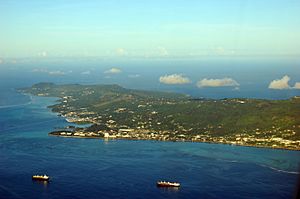
After Japan's defeat in World War II, the United States managed the Northern Marianas as part of the Trust Territory of the Pacific Islands (TTPI) for the United Nations. The U.S. was responsible for the islands' defense and foreign affairs.
Between 1958 and 1969, four votes were held to see if the islands wanted to join Guam or change their status. Most people voted to join Guam, but Guam rejected the idea in a 1969 vote.
In 1975, nearly 80% of voters in the Northern Mariana Islands chose to become a commonwealth of the United States. In 1977, over 93% approved the new constitution for the Commonwealth of the Northern Mariana Islands (CNMI). This new government started on January 9, 1978. The United Nations approved this plan. The Northern Mariana Islands officially became part of U.S. sovereignty on November 4, 1986, and the islanders became U.S. citizens.
In May 1981, volcanic eruptions on Pagan island forced people to leave. Most residents have not returned due to ongoing volcanic activity.
In the 1960s and 1970s, farming and ranching became important. Thousands of cattle, dairy cows, and pigs were raised, and many crops like pineapple were grown. This food production became a key supply for the Marianas region.
In December 1986, Typhoon Kim destroyed 20% of homes on Saipan. Trees were stripped, roads were blocked, and there was no electricity or water for weeks.
In April 1990, people living on the western coast of Anatahan had to leave because of earthquakes and active steam vents, which suggested a volcano might erupt. No eruption happened then. However, the first historical eruption of Anatahan occurred in May 2003. A large explosion sent an ash cloud 12 kilometers (7.5 miles) high, which affected air travel to Saipan and Guam.
The 21st Century
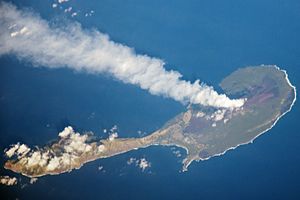
The Northern Mariana Islands do not have a voting representative in the United States Congress. However, since 2009, they have been represented in the U.S. House of Representatives by a delegate. This delegate can take part in debates and serve on committees, but cannot cast final votes on the House floor. This idea of a non-voting delegate has been around in the U.S. since before 1800. These delegates represent their region's interests and can speak on the floor. The position is also seen as a step towards gaining full voting rights.
In 2018, 18 people started a mission to repopulate the northern islands of Alamagan and Agrihan. These families originally came from Alamagan. The project was planned by the Mayor's office and included setting up a clean water supply and radio contact. The goal is to send more families to these islands. The 2020 U.S. Census reported only 7 people living on Alamagan and Agrihan.
Typhoon Yutu caused a lot of damage in October 2018. It was the strongest typhoon ever known to hit the islands. U.S. President Donald Trump declared an emergency for the Northern Islands on October 24, 2018.
Geography of the Islands
The Northern Mariana Islands and Guam (to the south) together form the Mariana Islands chain. The southern islands are made of limestone and have flat areas with coral reefs. The northern islands are volcanic, with active volcanoes on several islands, including Anatahan, Pagan, and Agrihan. The volcano on Agrihan, Mount Agrihan, is the highest point at 3,166 feet (965 meters). In 2018, an expedition made the first full climb to the top of this peak.
The Northern Mariana Islands include 14 main islands, listed from north to south. Some smaller islands are often grouped together. Zealandia Bank can sometimes be an island depending on the tide. The entire chain stretches for hundreds of kilometers. Many islands have several names, often from Spanish, Chamorro, or English. Volcanic activity has forced people to leave many islands.
Here are some of the islands:
- Farallon de Pajaros (or Uracus)
- Maug Islands (three islands: North, East, and West)
- Supply Reef, a submarine volcano near Maug, rises close to the surface.
- Asuncion Island
- Agrihan
- Pagan (mostly empty since a 1981 eruption)
- Alamagan
- Guguan
- Zealandia Bank, mostly underwater rocks that appear at low tide.
- Sarigan
- Anatahan, which had eruptions in 2003 and 2007–2008.
- Farallon de Medinilla
- Saipan
- Mañagaha (a small island west of Saipan)
- Bird Island (partially connected to Saipan on the east)
- Forbidden Island (partially connected to Saipan on the southeast)
- Tinian, a quiet island with cattle ranches and historical sites.
- Aguijan (Goat Island) (an uninhabited island south of Tinian, full of birds and goats)
- Naftan Rock
- Rota, also known as Friendly Island, which is also inhabited.
Anatahan Volcano is a small volcanic island about 80 miles (129 km) north of Saipan. It is about 6 miles (10 km) long and 2 miles (3 km) wide. Anatahan started erupting from its east crater on May 10, 2003. It has had periods of eruption and calm since then. On April 6, 2005, a huge amount of ash and rock was thrown out, creating a large black cloud that drifted south over Saipan and Tinian.
- Northernmost point – Farallon de Pajaros
- Easternmost point – Farallon de Medinilla
- Southernmost point – Puntan Malikok, Rota
- Westernmost point – Farallon de Pajaros
The islands are part of the Marianas tropical dry forests ecoregion.
The ocean area east of the islands, along with parts of the islands themselves, is part of the Marianas Trench Marine National Monument. This protected area includes three northernmost islands, the "Arc of Fire" refuge with 21 underwater volcanoes, and the deep trench region. This preserve aims to protect unique marine life like seabirds, sea turtles, special coral reefs, and life around underwater vents. The Marianas Trench itself has the deepest ocean water on Earth.
South of the CNMI is Guam. To the east is Wake Island, then Midway Island, and eventually the start of the Hawaiian Islands. American Samoa is southeast and below the Equator. To the north and east is Alaska, with its Aleutian Islands. To the west of the CNMI is the Philippines, and to the southwest is Palau. To the southeast is Micronesia, where many Carolinian people came from centuries ago.
Saipan has some smaller islands attached to it. One is Bird Island, a nature reserve for birds, connected to Saipan only at low tide. Forbidden Island is similar but larger and also connected at low tide.
Climate of the Islands
The Northern Mariana Islands have a tropical rainforest climate. This means it's hot and rainy all year, but the weather is made a bit milder by seasonal winds. There is not much change in temperature throughout the year. The dry season is from December to June, and the rainy season is from July to November. Typhoons can happen during the rainy season. The Guinness World Records has even said that Saipan has the most balanced climate in the world.
| Climate data for Saipan International Airport (1991–2020 normals, extremes 2000–present) | |||||||||||||
|---|---|---|---|---|---|---|---|---|---|---|---|---|---|
| Month | Jan | Feb | Mar | Apr | May | Jun | Jul | Aug | Sep | Oct | Nov | Dec | Year |
| Record high °F (°C) | 89 (32) |
90 (32) |
91 (33) |
93 (34) |
96 (36) |
94 (34) |
99 (37) |
95 (35) |
94 (34) |
92 (33) |
92 (33) |
90 (32) |
99 (37) |
| Mean daily maximum °F (°C) | 84.1 (28.9) |
84.0 (28.9) |
84.9 (29.4) |
87.1 (30.6) |
88.2 (31.2) |
88.4 (31.3) |
87.8 (31.0) |
87.2 (30.7) |
87.2 (30.7) |
86.6 (30.3) |
86.5 (30.3) |
85.7 (29.8) |
86.5 (30.3) |
| Daily mean °F (°C) | 79.5 (26.4) |
79.1 (26.2) |
80.0 (26.7) |
82.0 (27.8) |
83.1 (28.4) |
83.4 (28.6) |
82.9 (28.3) |
82.4 (28.0) |
82.2 (27.9) |
81.8 (27.7) |
81.9 (27.7) |
81.0 (27.2) |
81.6 (27.6) |
| Mean daily minimum °F (°C) | 74.8 (23.8) |
74.1 (23.4) |
75.2 (24.0) |
76.9 (24.9) |
78.0 (25.6) |
78.5 (25.8) |
78.1 (25.6) |
77.5 (25.3) |
77.2 (25.1) |
77.1 (25.1) |
77.3 (25.2) |
76.4 (24.7) |
76.8 (24.9) |
| Record low °F (°C) | 70 (21) |
69 (21) |
69 (21) |
70 (21) |
73 (23) |
72 (22) |
71 (22) |
69 (21) |
72 (22) |
69 (21) |
69 (21) |
69 (21) |
69 (21) |
| Average rainfall inches (mm) | 3.65 (93) |
2.50 (64) |
1.96 (50) |
2.75 (70) |
3.12 (79) |
4.24 (108) |
7.43 (189) |
12.86 (327) |
11.42 (290) |
10.72 (272) |
5.21 (132) |
3.78 (96) |
69.64 (1,769) |
| Average rainy days (≥ 0.01 in) | 17.4 | 15.3 | 14.2 | 16.4 | 17.9 | 20.2 | 24.3 | 23.9 | 23.3 | 24.5 | 20.7 | 18.9 | 237.0 |
| Source: NOAA | |||||||||||||
Government and Politics
The Northern Mariana Islands have a government system with many political parties, similar to a presidential democracy. They are a commonwealth of the United States. The U.S. Department of the Interior helps manage federal money sent to the islands.
The government is divided into three main parts, just like in the United States. The executive branch is led by the governor. The legislative power (the power to make laws) is held by two groups: the Senate and the House of Representatives. The judicial power (the power to interpret laws) belongs to the CNMI Supreme Court and other lower courts.
Island Divisions and Population
The islands cover a total area of about 179 square miles (464 square kilometers). The CNMI is divided into four main areas called municipalities.
The Northern Islands (north of Saipan) form the Northern Islands Municipality. The three main southern islands form their own municipalities: Saipan, Tinian, and Rota. The uninhabited island of Aguijan is part of Tinian municipality.
Many of the northern islands have been evacuated because of volcanic threats. In 2020, only seven people lived in the Northern Islands Municipality. The mayor's office for these islands is located on Saipan.
Saipan, Tinian, and Rota are the only islands with ports and are the only ones where people live permanently.
Political Status and U.S. Relationship
In 1947, after World War II, the Northern Mariana Islands became part of the Trust Territory of the Pacific Islands (TTPI), managed by the United States for the United Nations. In 1976, the U.S. Congress approved an agreement to make the Northern Mariana Islands a Commonwealth in political union with the United States. This agreement, called the Covenant, became law on March 24, 1976.
The CNMI government adopted its own constitution in 1977, and the new government started in January 1978. The Covenant fully took effect on November 3, 1986. This made the islanders U.S. citizens. It also allowed the CNMI to have a Resident Representative in Washington, D.C., to speak for them.
In 2008, the U.S. Congress created a special seat for a CNMI delegate in the U.S. House of Representatives. Gregorio Sablan was elected as the first delegate in November 2008. Like other delegates, he can join debates and vote in committees, but he cannot cast final votes on the House floor.
On December 22, 1990, the United Nations ended the TTPI agreement for the CNMI and other islands.
Under the Covenant, only certain parts of the U.S. Constitution apply to the Commonwealth. Laws passed by the U.S. Congress only apply to the CNMI if they also apply to all 50 states. The CNMI is outside the U.S. customs area, and its residents do not pay U.S. federal income tax.
At first, the CNMI had its own immigration system. However, after problems with how immigrant workers were treated, the U.S. took over immigration laws in 2009. Now, U.S. immigration laws apply to the Northern Mariana Islands.
Court System
Cases under federal law are heard by the District Court for the Northern Mariana Islands. This court was set up in 1977 and started in January 1978. It is located on Saipan. This court has the same powers as other U.S. district courts. Appeals from this court go to the Ninth Circuit.
Cases under local laws are heard by the Superior Court of the Commonwealth of the Northern Mariana Islands. Appeals from this court go to the Supreme Court of the Commonwealth of the Northern Mariana Islands.
Citizenship Rights
The Covenant agreement made legally qualified CNMI residents into United States citizens. This generally included all citizens of the CNMI. It also established U.S. birthright citizenship for people born in the CNMI. This means that children born in the Northern Marianas are U.S. citizens from birth.
The CNMI has some special visa programs. The U.S. government works with Asian countries and local Marianas officials to balance allowing access to the islands with preventing misuse of the system.
Economy of the Islands
The Northern Mariana Islands benefit from their trade relationship with the United States and from having workers from Asia. In the past, the CNMI's economy mainly depended on tourism, especially from Japan, and on making clothes. However, the garment factories on Saipan all closed by 2009 after trade rules changed. Tourism also decreased after 2005 when Japan Airlines stopped flying to the Marianas.
Farming is not a huge part of the economy, making up only a small percentage of the CNMI's total income. However, it is still important for the local community. The Marianas, with their many cattle and rich soil, help provide food for the region. Tinian is known as the "breadbasket" of the Marianas. Cattle from the CNMI supply beef to Guam, Palau, and Micronesia.
People who are not native islanders are not allowed to own land, but they can lease it.
Tourism in the CNMI
Tourism is very popular in the Northern Mariana Islands. Hundreds of thousands of people visit each year. One of the busiest years was 1997, when over 700,000 tourists came. Popular activities include jungle hikes, golfing, diving, and visiting historical sites like ancient stone pillars. One golf course was even designed by famous golfer Greg Norman.
A popular tourist spot is Managaha Island. You can reach it by ferry. It has barbecue vendors, water sports, and wide sandy beaches surrounding a tropical forest. Tourists from the U.S. do not need a visa. Visitors from other countries that qualify for special programs can usually stay for up to 45 or 90 days.
Some popular tourist places in the CNMI include:
- Managaha Island (a 100-acre tropical beach island reached by ferry)
- American Memorial Park
- Micro Beach, a 1-kilometer (0.6-mile) beach on the west side, great for sunsets.
- San Juan Beach, known for a unique stone formation that looks like a crocodile.
- Rad/Ladder/Coral Beach on southern Saipan, about 100 yards long, made mostly of coral pieces. It is popular for local barbecues and beach running.
- Obyan Beach, a long beach in the south known for colorful underwater life.
- Taga Beach (on Tinian island), the largest beach on Tinian, known for sunset views.
- Latte Stones Quarry (a very old stone quarry of the Chamorro people)
- Mount Tapochau (the highest point on Saipan, with views of the island and other islands on clear days; it has a statue of Jesus Christ at the top).
- Kalabera Cave (features ancient cave drawings)
- Last Command Post (the final Japanese command post during the Battle of Saipan)
- Bird Island Sanctuary Beach (a beach near the Bird Island sanctuary), which faces east. There is also an observatory nearby to watch the birds.
- Forbidden Island, a small island connected to Saipan at low tide, where you can hike. At high tide, water separates it. There is a lookout point nearby.
- Japanese Lighthouse (built in 1934 during Japanese rule, now a cafe with island views)
- NMI Museum of History and Culture
- The Grotto, a large underwater limestone cave on Saipan.
Island Infrastructure
The islands have over 220 miles (350 km) of highways. There are three airports with paved runways and three with unpaved runways, plus one heliport. The main airport for commercial flights is Saipan International Airport.
A local airline offers short flights between Guam, Saipan, Tinian, and Rota. For example, United Airlines started a three-hour flight to Narita, Japan (Tokyo), from Saipan in 2022.
To travel between islands, you often need to take charter boat trips. For example, a trip to Pagan is about 200 miles (320 km) by boat.
The U.S. Postal Service (USPS) handles mail for the islands. Each major island has its own ZIP code. The two-letter abbreviation for the CNMI is MP. For phone service, the islands use area code 670.
Television service is provided by KPPI-LD, Channel 7, which shows programs from Guam's ABC channel. WSZE, Channel 10, shows programs from Guam's NBC channel. There are also about 10 radio stations broadcasting in the CNMI.
In 2012, it was noted that internet prices in the CNMI were much higher than in Guam. In 2023, some federal money was given to help improve internet service.
Population and Culture
Island Population Changes
| Historical population | |||
|---|---|---|---|
| Census | Pop. | %± | |
| 1960 | 8,286 | — | |
| 1970 | 9,436 | 13.9% | |
| 1980 | 16,780 | 77.8% | |
| 1990 | 43,345 | 158.3% | |
| 2000 | 69,221 | 59.7% | |
| 2010 | 53,883 | −22.2% | |
| 2020 | 47,329 | −12.2% | |
In 2020, the population of the CNMI was 47,329. This was a decrease from 69,221 people in 2000. This drop happened for several reasons, including the closing of garment factories, economic problems, and less tourism.
The Northern Mariana Islands are the second least populated U.S. territory, after American Samoa. However, the population has changed a lot over time. It reached 80,000 in 2000, then dropped to around 50,000 in the 2010s. When the CNMI became U.S. citizens in 1986, the population was about 36,000. In 1950, it was about 7,000.
As of 2020, about 60% of the people are U.S. Citizens or legal permanent residents. The other 40% are foreign workers.
Some Marianans have moved to the mainland U.S., especially to the West Coast. One of the largest communities is in Washington State, with almost 5,000 people from the islands.
Languages Spoken
The official languages in the Northern Mariana Islands are English, Chamorro, and Carolinian. A few people still speak the very rare Tanapag language. Many Philippine languages, Chinese, and other Pacific island languages are also spoken. While Spanish surnames are common, the language itself is not widely used anymore, though some older people might still know it.
Ethnic Groups on the Islands
The Northern Marianas have a diverse mix of Asian and Pacific peoples. Based on the 2010 Census:
- Filipino: 35.3%
- Chamorro: 23.9%
- Multiracial (two or more backgrounds): 12.7%
- Chinese: 6.8%
- Other Hawaiian or Pacific Islander: 6.4%
- Carolinian: 4.6%
- Korean: 4.2%
- Other Asian: 3.7%
- Other: 2.5%
Religious Beliefs
Because of the Spanish missionaries in the Marianas, most Chamorros and Carolinians practice Roman Catholicism. The Japanese occupation led to a noticeable Buddhist community, which stayed even after the Japanese left. Due to the influence of the United States, different types of Protestantism also came to the islands.
Many people in the Northern Mariana Islands are Roman Catholic or have traditional beliefs. According to the Pew Research Center in 2010:
- Roman Catholic: 64.1%
- Protestants: 16%
- Buddhists: 10.6%
- Folk religions: 5.3%
- Other Christians: 1.2%
- Other religions: 1.1%
- Unaffiliated (no religion): 1.0%
- Eastern Orthodox: less than 1%
- Hindu: less than 1%
- Muslim: less than 1%
- Jews: less than 1%
Education System
The Commonwealth of the Northern Mariana Islands Public School System runs public schools in the commonwealth. There are also many private schools. Northern Marianas College is a college that offers programs similar to other small U.S. community colleges.
Culture and Traditions
Much of the Chamorro culture in the Mariana Islands was greatly influenced by the Spanish, Germans, and Japanese. Respect is a very important part of Chamorro culture. One common way to show respect is the tradition of "manngingi'". This old tradition involves a child taking the hand of an elder, placing it on their nose, and saying ñot to men or ñora to women. The elders then respond with diosti ayudi (meaning "God help you").
The Carolinian culture is very similar to Chamorro culture, with respect being very important. Carolinian culture comes from Yap and Chuuk. One difference between Guam and the Northern Marianas is the large number of Carolinian people and their culture that have moved to the Northern Marianas, in addition to the Chamorros.
Island Cuisine
The food of the Chamorro people is influenced by many cultures. Popular foods from other countries include different types of sweet or savory empanada, which came from Spain, and pancit, a noodle dish from the Philippines.
Evidence shows that rice has been grown in the Marianas since ancient times. Red rice, made with achoti, is a special food that makes Chamorro cuisine unique from other Pacific islands. It is often served at special events like parties, religious gatherings, and graduations. Fruits like lemmai (breadfruit), mangga (mangoes), niyok (coconuts), and bilimbines (a fruit related to starfruit) are used in many local recipes. Korean, Chinese, Japanese, and American foods are also commonly available.
Local specialties include kelaguen, a dish where meat is "cooked" by acid (like lemon juice) instead of heat. Another is tinaktak, a meat dish made with coconut milk. Kå'du fanihi (flying fox/fruit bat soup) is also a traditional dish. Fruit bats are now rare on some islands because too many were hunted, and their homes were lost. Hunting them is now against the law.
The Marianas and the Hawaiian islands eat the most Spam per person in the world. Spam was brought to the islands by the American military as food rations during World War II. Spam is a common meal or snack and is used in many recipes like Spam sushi, Spam pizza, Spam and eggs, and Spam-fried rice.
Cinema and Films
A small, independent film industry, mostly making documentary films, started in the Northern Mariana Islands in the 21st century. This happened thanks to efforts by the Commonwealth and the Northern Marianas College. Before this, foreign filmmakers had already shot movies on the islands in the 20th century.
In 2002, a new law created the Northern Mariana Islands Film Office. Its goal is to attract foreign companies to make movies in the Commonwealth and to help grow a local film industry.
Popular Sports
Team sports popular in the United States were brought to the Northern Mariana Islands by American soldiers during World War II. Baseball is the most popular sport on the islands. CNMI teams have played in the Little League World Series and have won gold medals in the Micronesian Games and South Pacific Games.
Basketball and mixed martial arts are also popular. The islands hosted the official 2009 Oceania Basketball Tournament. Trench Wars is the CNMI's own Mixed Martial Arts brand. Fighters from the CNMI have competed in major events like Pacific Xtreme Combat and the UFC.
Other sports played in the CNMI include Ultimate Frisbee, volleyball, tennis, soccer, outrigger sailing, softball, beach volleyball, rugby, golf, boxing, kickboxing, tae kwon do, track and field, swimming, triathlon, and football.
The islands have several golf courses, mostly on Saipan and often near resorts. As of the 2020s, there are four golf courses on Saipan: Marianas Country Club, Laolao Bay Country Club, Coral Ocean Point Resort Club, and Kingfisher Golf Links. On Rota island to the south, there is another, Rota Resort & Country Club. All courses have 18 holes.
Flora and Fauna of the Islands
The official bird of the Northern Marianas islands is the Mariana fruit dove. The official flower is the Plumeria. The islands are home to many tropical plants and animals. Around the islands, you can find marine life like whales and dugongs.
About 80% of the islands are covered by tropical forest. Trees include palm, banana, pine, fern, and plumeria. There are many types of coral around the islands, and many islands are surrounded by coral reefs. Some islands have over 60 different species of coral.
There are nine known bird species that live only in the Northern Marianas, such as the Saipan Reed Warbler and Golden white-eye. There are also many different invertebrates, insects, and plants. Some examples include Langford's Tree Snail (Partula langfordi) and the Tree Fern (Cyathea aramaganensis).
See also
 In Spanish: Islas Marianas del Norte para niños
In Spanish: Islas Marianas del Norte para niños




